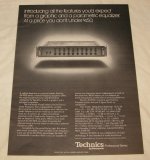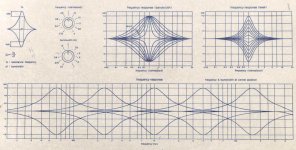Flat in room LF response spatially averaged is the key, and only multiple LF sources can do this in a small room.
Sometimes one single subwoofer and a good EQ is all you need:
An externally hosted image should be here but it was not working when we last tested it.
Best, Markus
Sometimes one single subwoofer and a good EQ is all you need:
An externally hosted image should be here but it was not working when we last tested it.
Best, Markus
Markus
There are no hard and fast rules when one is tal;king about LF in small rooms. Every situation is unique.
Markus
There are no hard and fast rules when one is tal;king about LF in small rooms. Every situation is unique.
Yes, that's probably the only valid rule. Nonetheless it shows that measurments are indispensable. This is the frequency response with the subwoofer in a corner, downfiring (could be worse):
An externally hosted image should be here but it was not working when we last tested it.
In corner at ear level:
An externally hosted image should be here but it was not working when we last tested it.
After EQing:
An externally hosted image should be here but it was not working when we last tested it.
Lift at 25Hz:
An externally hosted image should be here but it was not working when we last tested it.
Small (average german) living rooms
Categorization of frequency ranges in room acoustics:
A from 'lower frequency limit of hearing' to
B '1st room mode' to
C 'Schröder frequency' to
D 'Schröder frequency x 4' to 'Upper frequency limit of hearing'
Categories based on:
Michael, Dickreiter: Handbuch der Tonstudiotechnik, Band 1, 6. Auflage,
München: K.G. Saur Verlag, 1997
-----------------
A: Room pressurization, no wave propagation
B: Modal range
C: Transition range between 'modal' and 'statistical' range
D: Statistical range
Example (self constructed):
Typical Ranges for an average german living room of
Area : 22 m^2
Height : 2,55 m
Volume : 56 m^3
T60 : 0,7 s (lightly to medium damped)
Fs=2000 x (T/V)^0.5 = 223Hz (Schroeder frequency)
Approximate ranges [Hz]:
(lowest mode depending on proportions, here: 5.5m x 4m)
A: _20____62
B: _62___223
C: 223___892
D: 892___20000
892 Hz converts to a subjective pitch of 926 mel
20000 Hz converts to a subjective pitch of 3817 mel
Bark Scale:
http://www.phonetik.uni-muenchen.de/~reichelu/kurse/perzeption/folien_perzeption_5_reichel.pdf
Calculator for auditory units:
Conversion between Hz, semitones, bark, ERB, etc.
Categorization of frequency ranges in room acoustics:
A from 'lower frequency limit of hearing' to
B '1st room mode' to
C 'Schröder frequency' to
D 'Schröder frequency x 4' to 'Upper frequency limit of hearing'
Categories based on:
Michael, Dickreiter: Handbuch der Tonstudiotechnik, Band 1, 6. Auflage,
München: K.G. Saur Verlag, 1997
-----------------
A: Room pressurization, no wave propagation
B: Modal range
C: Transition range between 'modal' and 'statistical' range
D: Statistical range
Example (self constructed):
Typical Ranges for an average german living room of
Area : 22 m^2
Height : 2,55 m
Volume : 56 m^3
T60 : 0,7 s (lightly to medium damped)
Fs=2000 x (T/V)^0.5 = 223Hz (Schroeder frequency)
Approximate ranges [Hz]:
(lowest mode depending on proportions, here: 5.5m x 4m)
A: _20____62
B: _62___223
C: 223___892
D: 892___20000
892 Hz converts to a subjective pitch of 926 mel
20000 Hz converts to a subjective pitch of 3817 mel
Bark Scale:
http://www.phonetik.uni-muenchen.de/~reichelu/kurse/perzeption/folien_perzeption_5_reichel.pdf
Calculator for auditory units:
Conversion between Hz, semitones, bark, ERB, etc.
Last edited:
Markus
If you think about it, if every situation is unique, then measurements are an absolute requirement to know what you have. Otherwise its just guessing.
Oliver
Those frequencies are all way too high. In my room, and I've measure this, pressurization occurs to about 38 Hz. Then the modal region goes to about 120 Hz and to 200 Hz the modal density is a bit sparse. But 200 - 20,000 is completely statistical. SO in terms of decades, the first decade is mostly modal, then the next two are completly statistical. Thats the way I think about it.
If you think about it, if every situation is unique, then measurements are an absolute requirement to know what you have. Otherwise its just guessing.
Oliver
Those frequencies are all way too high. In my room, and I've measure this, pressurization occurs to about 38 Hz. Then the modal region goes to about 120 Hz and to 200 Hz the modal density is a bit sparse. But 200 - 20,000 is completely statistical. SO in terms of decades, the first decade is mostly modal, then the next two are completly statistical. Thats the way I think about it.
If you think about it, if every situation is unique, then measurements are an absolute requirement to know what you have. Otherwise its just guessing.
Which is unfortunately what most people do. The difference is like day and night and still they argue about cables...
Dear Mr. Geddes,
i know that those frequencies are quite high and this is
for sure not the ideal room for listening.
But it is a kind of room which has to be expected, when
an average consumer sets up his equipment.
Maybe not the average 'high end' consumers listening room of course.
I have observed modal behaviour even in a larger than average
room up to about 360 Hz, there were pronounced local pressure maxima
which could be influenced by changing the position of the speaker.
That room was not too far from cubical unfortunately and
hat rather 'naked' walls on three sides.
Your listening room might be somewhat larger than 'german average'
i suppose and might be treated/damped professionally for its purpose.
i know that those frequencies are quite high and this is
for sure not the ideal room for listening.
But it is a kind of room which has to be expected, when
an average consumer sets up his equipment.
Maybe not the average 'high end' consumers listening room of course.
I have observed modal behaviour even in a larger than average
room up to about 360 Hz, there were pronounced local pressure maxima
which could be influenced by changing the position of the speaker.
That room was not too far from cubical unfortunately and
hat rather 'naked' walls on three sides.
Your listening room might be somewhat larger than 'german average'
i suppose and might be treated/damped professionally for its purpose.
Last edited:
so measurements and equalizers are indispensable
Can anybody recommend any consumer or semi-pro measurement gear?
Are there any consumer or semi-pro equalizers worth buying?
Behringer perhaps?
Or rather there is no escape from computer audio? 🙁
Can anybody recommend any consumer or semi-pro measurement gear?
Are there any consumer or semi-pro equalizers worth buying?
Behringer perhaps?
Or rather there is no escape from computer audio? 🙁
The Behringer DEQ2496 has built-in measurement capabilities. An other alternative worth considering (not as flexible however) is a Sony digital amplifier with room correction.
so measurements and equalizers are indispensable
Can anybody recommend any consumer or semi-pro measurement gear?
Are there any consumer or semi-pro equalizers worth buying?
Behringer perhaps?
Or rather there is no escape from computer audio? 🙁
Use HolmImpulse and the DCX2496. DO NOT USE the built in measurement system in the DEQ
Who wants to escape from Computer Audio - its a God send!
Last edited:
Sometimes one single subwoofer and a good EQ is all you need:
An externally hosted image should be here but it was not working when we last tested it.
Best, Markus
That's an impressive looking result. Is it just as good when you move to the next seat?
Is it just as good when you move to the next seat?
Would have to take additional measurements. This is a one seat optimization. Here's listening location, 15cm to the left and to the right:
An externally hosted image should be here but it was not working when we last tested it.
The Behringer DEQ2496 has built-in measurement capabilities. An other alternative worth considering (not as flexible however) is a Sony digital amplifier with room correction.
tough choice, I had DEQ and I didn't like it
what about Audyssey 2EQ™ Room Acoustic Correction in Onkyo receivers?
tough choice, I had DEQ and I didn't like it
what about Audyssey 2EQ™ Room Acoustic Correction in Onkyo receivers?
It's like Key's "system", nobody knows what it does 🙂 A more sophisticated approach to "room" correction is (((acourate)))® - Room Correction, Speaker Optimization and Sound Improvement
Measurements: If you're a Mac guy like me, get FuzzMeasure, ART USB Dual Pre, Behringer ECM8000, mike stand, cables and you're all set.
Use HolmImpulse and the DCX2496. DO NOT USE the built in measurement system in the DEQ
o yes indeed, I know because I used it, now DEQ is sold
Can I use parametric analogue equalizer instead? Can it possibly be sufficient?
I had two vintage parametric 5-bands stereo EQs with continuously variable Qs and center frequencies
Connecting them one after another would give me two bands 20-180 Hz
and two bands 80-720 per stereo channel.
Is it worth trying or just a waste of time?
Attachments
Last edited:
It's like Key's "system", nobody knows what it does 🙂
I see 🙂
Measurements: If you're a Mac guy like me, get FuzzMeasure, ART USB Dual Pre, Behringer ECM8000, mike stand, cables and you're all set.
well I am not but perhaps I am destined to become 😉
thanks for suggestions 🙂
just a waste of time?
Yes, because below 100Hz you want to target single modes with 1Hz accuracy.
well I am not but perhaps I am destined to become 😉
No, become a PC guy so Earl has to support you 😉 You just need to replace FuzzMeasure with HOLMImpulse. Then Earl could even sell you some subs with a DCX2496 setup fitted to your room 🙂
Small example room
Lowest room mode was one octave too high (ehem 😱 ):
A: _20____31
B: _31___223
C: 223___892
D: 892___20000
sorry, couldn't go to sleep before correction.
Approximate ranges [Hz]:
(lowest mode depending on proportions, here: 5.5m x 4m)
A: _20____62
B: _62___223
C: 223___892
D: 892___20000
[/url]
Lowest room mode was one octave too high (ehem 😱 ):
A: _20____31
B: _31___223
C: 223___892
D: 892___20000
sorry, couldn't go to sleep before correction.
- Home
- Loudspeakers
- Multi-Way
- The Advantages of Floor Coupled Up-Firing Speakers

